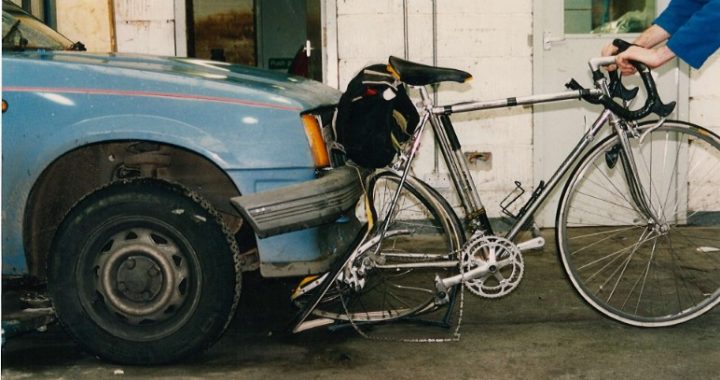Be seen! But that’s only half the problem. Everything else is down to the nut behind the wheel.
The stats are that in 44% of collisions either of the parties did not see the other and in 21% there was a failure to appreciate the speed of the other vehicle.
Behind that are some physiological factors acting upon a human’s abilities to control a vehicle, meaning how readily can the presence of a cyclist be clocked and once seen how long it takes a motorist to do something about it.
Let’s consider the ‘doing something about it’ aspect first, meaning the thinking or reaction time.
All the studies into reaction time come up with a real world figure of between 1.5 and 2 seconds. That is the basis for crash reconstruction used by the Transport Research Laboratory (TRL) and the Institute of Traffic Accident Investigators (ITAI).
What does that mean in terms of distance? Example: at 60 mph (national speed limit which applies on the majority of rural roads) a vehicle will travel the length of a football field (112 yards or 102m) in 3.8 seconds.
Using a really quick reaction time, from perception to doing something about it, (1.5s x 26.80m) it’s covered 40m or 132 feet. Then it has to slow down or stop.
At 30mph, the predominant limit in urban areas it’s still 66 feet (four and a half car lengths), or 20m before the brakes go on or avoidance is begun.
But first the driver has to see, or perceive, that there’s something to avoid or to which it’s necessary to react. As we enter the time of year when the hours of darkness exceed those of light making oneself ‘there to be seen’ is crucial.
The pool of light from a dipped beam headlight is generally in the 56 to 60m bracket. Tests undertaken by Sussex Police (among others) indicate that a person in predominantly dark clothing (a darker shade of grey) will be likely to be perceived at 24-26m while white or bright clothing increases that to 45m.
Then we come to the actual ability to look and see. There’s a general tendency to assume that we are more conspicuous than we really are.
The ‘relaxed’ (or fatigued) focal distance of the human eye is between 11 to 13m. That’s the default setting if you will. Looking further requires an actual input. Additionally visual acuity reduces by up to 70% at only a small deviation away from the central field of vision, which is 5 degrees from the central axis. So part of the perception reaction process is likely to involve rotation of the head, movement of the eye and re-focussing.
Be mindful of the concept of ‘looming’. The problem is the ability to determine the correct distance and speed of the approaching cyclist. If the cyclist moves 20 m (from 160 to 140m distant) the perceived size will increase by only 10%. But the same cyclist moving at the same speed between 40 and 20m distant will double in size. Think of the analogy of a distant train approaching a platform. Refer back to the opening: 21% of collisions result from failure to appreciate the speed of an approaching vehicle (cyclist).
A single front light may be discerned as a cycle, but a driver planning to emerge from a side road into the cyclist’s path will be juggling preconceived notions of cycle speed against the light which will (may) be seen but by virtue of its small size increasing only marginally until the final seconds, especially if ‘merging’ into a backdrop of other vehicles’ headlights.
That’s quite a lot to happen in the ‘thinking distance’. So even though a cyclist may derive a feeling of safety from being ‘there to be seen’, that is no guarantee that the driver has actually registered him (or her) through the flak of other competing distractions upon the driver’s attention; dealing with the inevitable driving tasks (risk situations) and the processing of information from legitimate vehicle systems to say nothing if in-car entertainment, navigational devices and mobile phones.
Lights, Clothing, Retro-reflective if we all want to be here when the clocks go forward.

